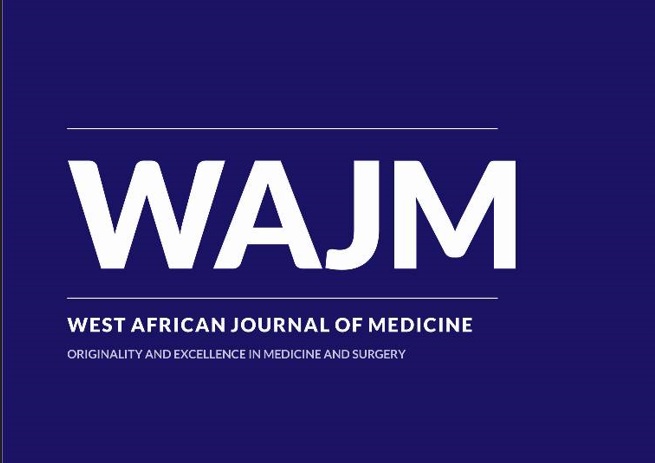EDITORIAL: HIV Associated Nephropathy
West Afr J Med. 2021 April; 38(4): 300-301 PMID: 33900703
Abstract
Human immunodeficiency virus infection can lead to progressive deterioration in renal function known as HIV-associated nephropathy (HIVAN). Importantly, individuals of African ancestry are more at risk than their European descent counterparts.
There is a wide geographical variation in the prevalence of HIV-associated nephropathy ranging from 38% to 48.5% worldwide. Few publications are available about prevalence in African Countries. Despite the global recommendation and use of combine active antiretroviral therapy in treating HIV-infected patients, HIVAN is a leading cause of chronic renal disease in HIV-1 positive individuals.
HIVAN was described in persons living with AIDS in 1984 but earlier named AIDS-associated nephropathy. HIV- positive cases showed similar clinic pathological features. The nephropathy is more common amongst people of African descent, largely due to polymorphism in APOL1 gene. Two APOL1 risk alleles, G1 (containing two missense mutations, rs73885319 and rs60910145) and G2 (a frameshift deletion rs71785313), at the serum resistance–associated interacting-domain-encoding region of APOL1 are associated with an increased susceptibility to developing HIVAN. Although individuals with HIVAN are predominantly males, studies have failed to show a direct correlation between gender or age and HIVAN.
Presentation is usually with low CD4 count, high viral load and massive proteinuria and renal insufficiency. Manifestations include hypoalbuminaemia, with almost little or no peripheral oedema and hypertension, a very rapid progression to end-stage renal disease with normal or enlarged kidney sizes. Renal histology shows global or focal segmental glomerulosclerois, degenerative and hypertrophic changes in visceral epithelial cells, mesangial deposits of C3, IgM and at times IgG, microcystic tubular dilatation containing plasma proteins, interstitial oedema and tubuloreticular inclusions in glomerular and peritubular endothelial cells. Significantly, collapsing glomerulopathy was not included in earlier reports until 1986. The histological lesions are however very similar to heroin-associated nephropathy or idiopathic FSGS.
Typically, there is glomerular basement membranes collapse, with hypertrophy and hyperplasia of glomerular epithelial cells, and active tubulointerstitial disease indicated by microcytic tubular dilatation, interstitial inflammation and tubular injury. Microcystic changes are the most consistent renal findings in HIVAN and these lesions were responsible for the renal enlargement.
The estimated prevalence of HIVAN in Nigeria was estimated to be 77% and 76.7% in the age group of 21 – 40 years. Surprisingly, children with HIV are not protected against HIVAN. The prevalence of HIVAN in children in Nigeria was estimated to be 31.6% associated with high mortality. Risk factors in children include proteinuria, advanced disease, low CD4 count and the use of the combined highly active antiretroviral therapy (HAART).
The finding of HIVAN amongst children, who acquired HIV-1 through vertical transmission in the late 1980s, indicated the presence of HIV-related glomerulopathy that could evolve independently of intravenous drug use. As documented by the authors of ‘HIV associated Nephropathy among Children with Renal Disease in Port Harcourt’ in this edition of the West African Journal of Medicine, the true prevalence of HIVAN among African children is largely unknown due to lack of surveillance and reporting. Similar to Anochie et al the authors reported on the similar number of cases (10) of HIVAN seen over a longer period of 6years but with a better outcome. They documented a HIVAN prevalence of 8.9% considered lower than earlier Nigerian studies. The finding of vertical transmission as the major route in thier study is in keeping with observations reported in other studies. However, the homosexual route of transmission identified in the study has rarely been reported among the paediatric population. The practice of homosexuality is a new mode of HIV transmission the authors reported among adolescent paediatric cases. Whether this will affect the clinical history in children is yet to be known.
The benefit of screening for HIVAN should be part of the routine follow tests for individuals with HIV on basis of 4 - 6 months to enable early diagnosis. This should include urine for albuminuria, proteinuria and plasma test for creatinine and eGFR.
References
- Patricio E. Ray. HIV-associated nephropathy: a diagnosis in evolution. Nephrol Dial Transplant (2012) 27: 3969– doi: 10.1093/ndt/gfs114.
- Laura Palau1, Steven Menez1, Javier Rodriguez-Sanchez, Tessa Novick, Marco Delsante, Blaithin A McMahon and Mohamed G Atta1HIV-associated nephropathy: links, risks and management. HIV/AIDS - Research and Palliative Care 2018:10 73–81.
- Nazik Elmalaika Husaina, Mohamed H. Ahmedb, h, Ahmed O. Almobarakc, Sufian K. Noord, Wadie M. Elmadhoune, Heitham Awadallaf et al. HIV-Associated Nephropathy in Africa: Pathology, Clinical Presentation and Strategy for Prevention. J Clin Med Res. 2018;10(1):1-8.
- Christina M. Wyatt and Paul E. Klotman. HIV-1 and HIV-Associated Nephropathy 25 Years Later. Clin J Am Soc Nephrol 2: S20–S24, 2007. doi: 10.2215/CJN.03561006
- Anochie IC, Eke FU, Okpere AN. Human immunodeficiency virus-associated nephropathy (HIVAN) in Nigerian children. Pediatr Nephrol 2008; 23(1):117-22.


